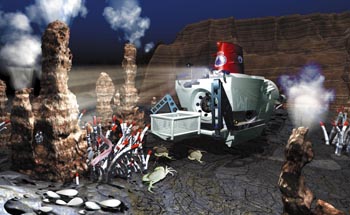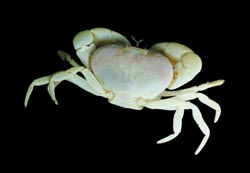9:55 a.m., Dec. 6, 2002--The crabs that inhabit vents found deep on the ocean floor have developed a form of eyesight similar to that of night vision goggles used by the military, according to University of Delaware researcher Charles E. Epifanio.
 |
| UD scientists collaborated with researchers at other institutions on a National Science Foundation-funded study of crabs that live 1.5 miles deep alongside volcanic vents in the Pacific Ocean. (Photo illustration by Dave Barczak.) |
Epifanio, a professor in UD’s College of Marine Studies who has done extensive work with the larvae of the blue crab that inhabits the shallow waters of the Mid-Atlantic coast, was part of a collaborative team involved in a three-year study of the larvae of the vent crab, Bythograea thermydron.
The team’s findings were published recently in the science journal Nature and have generated interest internationally.
Epifanio said the project, which was funded by the National Science Foundation, was designed to look at the dispersal of crab larvae from one vent site to another.
The volcanic vents, which spew hot water at temperatures of up to 350 degrees Centigrade, are found more than 1.5 miles deep along the Pacific Ocean’s mid-ocean ridge, are far flung and have a life span that is relatively short on the geologic scale, lasting decades rather than centuries.
“The big scientific question,” Epifanio said, “was how are these vents populated by organisms?
 |
| University of Delaware researcher and professor in the College of Marine Studies Charles E. Epifanio: “The vents are extremely unique and the community of organisms that lives there has evolved to live there and only there.” |
“The vents are extremely unique and the community of organisms that lives there has evolved to live there and only there,” he said. “We wanted to look at how the communities are established and maintained. We have done similar work on the larval distribution of the blue crab in shallow waters and, with NSF support, wanted to look at the vent crabs.”
In the course of the study, Epifanio found something unusual about the vent crab larvae–unlike almost any other creature in the vent community, they could survive the extreme changes in light, temperature and water pressure on the trip from the vents to the research ship.
“Generally when we bring organisms up to the surface, they die of depressurization or temperature shock,” Epifanio said. “These larvae were not susceptible to that, so we were able to handle them in the laboratory.”
The UD team found it could culture the vent crab larvae through the first several juvenile stages, keeping them alive for several months. “We found we could get through five stages, each punctuated by a molt,” Epifanio said.
Discovering this, the UD researchers put out the word to colleagues. “We have these unique animals, and you can’t get them anywhere else,” Epifanio said. “Other researchers jumped at the chance. We took the samples and cultured the larvae, and they did the physiology.”
Robert N. Jinks headed a research team at Franklin and Marshall College in Lancaster, Pa., and Thomas W. Cronin did work at the University of Maryland Baltimore County. Assisting Epifanio in the UD laboratories were Gina Perovich, a graduate student who earned a master of science degree in 2001, and Ana I. Dittel, an associate scientist.
 |
| A full-grown vent crab, Bythograea thermydron. |
What the physiologists found was that in the early larval forms, the eyes of the vent crabs appeared normal externally and were much like those of shallow water crabs. But upon metamorphosis, the eyes were highly degenerative and, in the end, became naked retinas.
“The eyes changed dramatically to deal with different wavelengths of light,” Epifanio said. “Vents produce light in the infrared wavelengths and the bottom line is, they basically have night vision as can be found in night vision goggles.”
Nature reports that the “planktonic zoea larvae of the vent crab possess image-forming compound eyes with a visual pigment sensitive to the blue light of mesopelagic waters. As they metamorphose and begin to descend to and settle at the vents, they lose their image-forming optics and develop high-sensitivity naked-retina eyes.”
The article continues, “The spectral absorbance of the visual pigment in these eyes shifts towards longer wavelengths from larva to postlarva to adult. This progressive visual metamorphosis trades imaging for increased sensitivity, and changes spectral sensitivity from the blue wavelengths of the larval environment towards the dim, longer wavelengths produced in the deeper bathypelagic vent environment of the adults. As hydrothermal vents produce light, vision may supplement thermal and chemical senses to orient postlarval settlement at vent sites.”
Epifanio and Dittel were joined by UD’s Craig Cary, associate professor of marine studies, as co-investigators for the NSF grant that supported the study reported in Nature.
Article by Neil Thomas
University of Delaware photos
|

